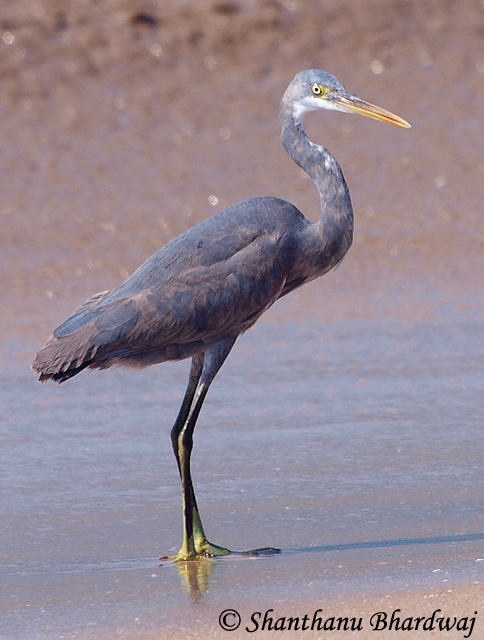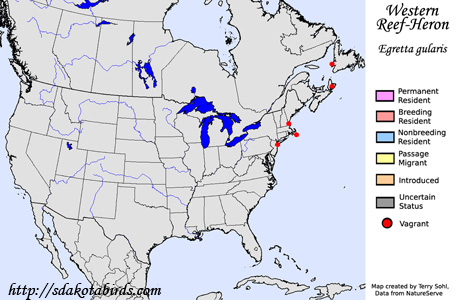| Length: 26 inches | Wingspan: 45 inches | Seasonality: Non-resident in South Dakota |
| ID Keys: Two color morphs, one bluish-gray with a white throat, the other has all-white plumage, dark legs with yellow feet | ||
 The
Western Reef-Heron is a native of the Old World, with populations along the
west coast of Africa, the east coast of Africa, and the coasts of the Middle
East through India. In North America, they were unknown until a bird
spent a summer on Nantucket Island in Massachusetts in 1983. Since
then, other sightings have occurred in the northeastern United States and in
southeastern Canada. Sightings have also occurred more frequently in
the Caribbean, as well as the east coast of South America. Western
Reef Herons thus are known to wander widely from their normal range, and
additional sightings in North America are considered likely.
The
Western Reef-Heron is a native of the Old World, with populations along the
west coast of Africa, the east coast of Africa, and the coasts of the Middle
East through India. In North America, they were unknown until a bird
spent a summer on Nantucket Island in Massachusetts in 1983. Since
then, other sightings have occurred in the northeastern United States and in
southeastern Canada. Sightings have also occurred more frequently in
the Caribbean, as well as the east coast of South America. Western
Reef Herons thus are known to wander widely from their normal range, and
additional sightings in North America are considered likely.
Habitat: Found near the coastline, on rocky or sandy shorelines, in mangrove swamps, in tidal estuaries and swamps, and quiet lagoons.
Diet: Feeds on fish, crustaceans, mollusks, marine worms, and other marine life. May also sometimes feed on terrestrial vertebrates such as small rodents.
Behavior: Forages during daylight hours, moving along mudflats or in shallow water in search of prey.
Nesting: The nest is a platform of sticks and seaweed, placed on the ground, in a mangrove, low in vegetation, or on a rocky shelf. The female lays 2 or 3 eggs, and both parents help to incubate them. After the eggs hatch, both parents help feed and tend to the young. The young leave the nest after about 28 days.
Song: Usually silent but they do have a squawking call, most often heard on nesting grounds, or when disturbed.
Migration: Movements of the species are not well understood, but it is apparent that at least some populations are migratory, and may disperse widely after the breeding season concludes.
Interactive eBird map: Click here to access an interactive eBird map of Western Reef Heron sightings
Similar Species: White-plumaged birds could be confused with Great Egret, but especially with the Little Egret or Snowy Egret. The dark-plumaged bird could be confused with the Tricolored Heron, or possibly the Great Blue Heron.
Conservation Status: Populations are considered stable and they are found over a wide geographic range. The IUCN lists the Western Reef-Heron as a species of "Least Concern".
Further Information: 1) Audubon Guide - Western Reef-Heron
2) ARKIVE.org - Western Reef-Heron
3) Whatbird.org - Western Reef-Heron
Photo Information: Photo taken by Shanthanu Bhardwaj - December 28th, 2008 - India - Photo licensed under Creative Commons Attribution ShareAlike 2.0 Generic License.
| Click below for a higher-resolution map |
 |
| South Dakota Status: Non-resident in South Dakota |
Additional Western Reef Heron Photos (coming soon!!)
